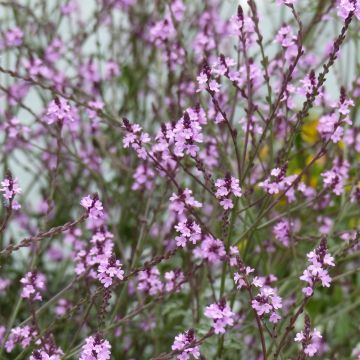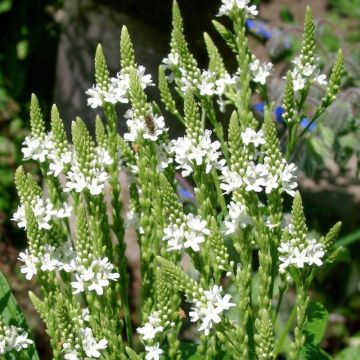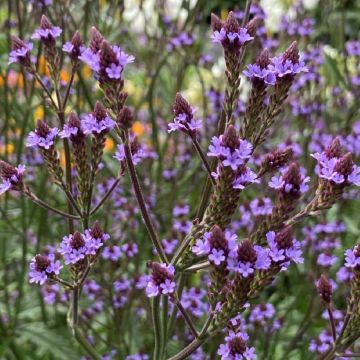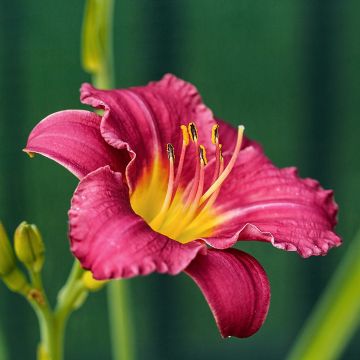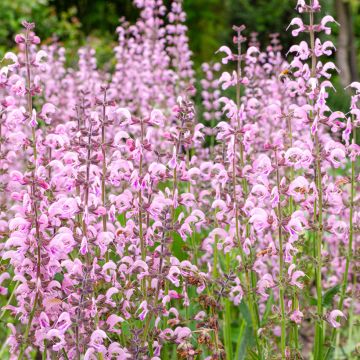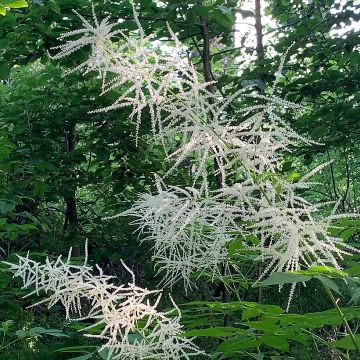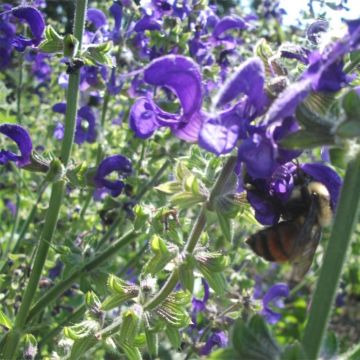

Duo of Verbena hastata
Duo of Verbena hastata
Verbena hastata Rosea, bleue.
Verveine des marais - verveine hastée
Be careful because the height of the plant indicated by Promesse de Fleurs is not accurate! The adult plant reaches a height of 2m (7ft), which can cause real aesthetic problems when designing flower beds based on the dimensions provided! This verbena self-seeds very easily, last year I cut them after flowering when they were in seed and threw them in the compost. They were covered with mown grass and various vegetation, and this year I discovered flowering plants in my compost pile. The stems are strong and resistant to wind, providing light and airy touches of colour to be reserved for the background of the flower beds.
Thomas, 21/09/2022
This item cannot be shipped to the selected country
Delivery charge from €5.90
More information
Delivery charge from €5.90
More information
Schedule delivery date,
and select date in basket
This plant carries a 12 months recovery warranty
More information
We guarantee the quality of our plants for a full growing cycle, and will replace at our expense any plant that fails to recover under normal climatic and planting conditions.
From €5.90 for pickup delivery and €6.90 for home delivery
Express home delivery from €8.90.

Does this plant fit my garden?
Set up your Plantfit profile →
Collection items (2 plants)
Description
A Duo of Verbena hastata with soft pink and lavender blue flowerings. These are stately perennials full of poetry to be tried in a large planting bed or near water. Their flowers, made of fine branching candelabras formed by very straight spikes, covered with tiny flowers, renew themselves for at least three months, in summer, and their vegetation also adorns itself with very beautiful colours in autumn. They succeed everywhere, in any humid, damp or occasionally dry soil, in the sun, and self-seed easily in the garden.
This duo consists of:
1x Pink hastate Verbena: with spikes covered with tiny pink flowers with purple bracts.
1 x Blue hastate Verbena: the same, with flowers of a soft and bright lavender blue.
Originally from Canada and the United States, Verbena hastata, belongs to the family of Verbenaceae. In nature, it colonises damp soil, riverbanks, wet meadows, and flood plains. It is a perennial herbaceous plant, but of short life, sometimes considered as an annual or biennial. Depending on the moisture of the soil, it will reach 60 cm (24in) to 1m (3ft) in height, by 50 to 60 cm (20 to 24in) in width. It develops from a fibrous and rhizomatous stump, forming an erect, narrow tuft, composed of quadrangular stems sometimes ramified towards their ends. The leaves are opposite, 10 to 13 cm (4 to 5in) long, 2.5 cm (1in) wide, lanceolate, veined, coarsely dentate, bright green in color until summer. The vegetation of this Verbena takes on beautiful shades of pink, purple, yellow, and orange from late summer to the first frosts. From June to September, the stems branch out at their upper ends and give rise to thin and pointed inflorescences, 10 to 15 cm (4 to 6in) in length, composed of numerous buds opening into small five-petal flowers, 5 mm (1in) in diameter, from bottom to top. The flowering is followed by the formation of small, very hard, elongated fruits containing seeds that self-seed easily. Small colonies of plants are also produced from the rhizomes. Plants grown from seeds are more vigorous and more tolerant to drought.
Still little used in our gardens, Verbena hastata is nevertheless easy to grow, valuable for bringing vertical lines to perennial beds, and delightful in cottage gardens. This plant is remarkable at the edge of a water, in damp soil, provided it is planted as a group. In a slightly wild scene, it emerges from the disheveled or orderly tufts of amaranths, aster laevis, and grasses (small miscanthus, eragrostis, stipes). It also performs quite well in drier soil, however, it will remain smaller. Its light, very architectural spikes, contrast with the roundness of roses, and its purple stems wonderfully accompany the grey or silver foliage of artemisias, the metallic blue of Elymus magellanicum, or rust of Carex buchananii. The Verbena hastata can also be used to prepare herbal teas.
Flowering
Foliage
Plant habit
Botanical data
Verbena
hastata
Rosea, bleue.
Verbenaceae
Verveine des marais - verveine hastée
North America
Other Verbena - Vervain
Planting and care
Plant Verbena hastata in ordinary soil, even occasionally flooded or dry, neutral, acid or chalky, preferably in the sun or in light shade in very hot regions. In shaded and humid conditions, it may be susceptible to powdery mildew. However, it prefers loamy and fertile soils, deep enough to accommodate its developing root system. Remove faded flowers as they appear to limit spontaneous sowing. It is a short-lived perennial, which can, under certain growing conditions, behave like an annual or biennial. Regular removal of faded flower spikes can prolong its lifespan. These plant self-seeds.
Planting period
Intended location
Care
-
, onOrder confirmed
Reply from on Promesse de fleurs
Summer flowering perennials
Haven't found what you were looking for?
Hardiness is the lowest winter temperature a plant can endure without suffering serious damage or even dying. However, hardiness is affected by location (a sheltered area, such as a patio), protection (winter cover) and soil type (hardiness is improved by well-drained soil).

Photo Sharing Terms & Conditions
In order to encourage gardeners to interact and share their experiences, Promesse de fleurs offers various media enabling content to be uploaded onto its Site - in particular via the ‘Photo sharing’ module.
The User agrees to refrain from:
- Posting any content that is illegal, prejudicial, insulting, racist, inciteful to hatred, revisionist, contrary to public decency, that infringes on privacy or on the privacy rights of third parties, in particular the publicity rights of persons and goods, intellectual property rights, or the right to privacy.
- Submitting content on behalf of a third party;
- Impersonate the identity of a third party and/or publish any personal information about a third party;
In general, the User undertakes to refrain from any unethical behaviour.
All Content (in particular text, comments, files, images, photos, videos, creative works, etc.), which may be subject to property or intellectual property rights, image or other private rights, shall remain the property of the User, subject to the limited rights granted by the terms of the licence granted by Promesse de fleurs as stated below. Users are at liberty to publish or not to publish such Content on the Site, notably via the ‘Photo Sharing’ facility, and accept that this Content shall be made public and freely accessible, notably on the Internet.
Users further acknowledge, undertake to have ,and guarantee that they hold all necessary rights and permissions to publish such material on the Site, in particular with regard to the legislation in force pertaining to any privacy, property, intellectual property, image, or contractual rights, or rights of any other nature. By publishing such Content on the Site, Users acknowledge accepting full liability as publishers of the Content within the meaning of the law, and grant Promesse de fleurs, free of charge, an inclusive, worldwide licence for the said Content for the entire duration of its publication, including all reproduction, representation, up/downloading, displaying, performing, transmission, and storage rights.
Users also grant permission for their name to be linked to the Content and accept that this link may not always be made available.
By engaging in posting material, Users consent to their Content becoming automatically accessible on the Internet, in particular on other sites and/or blogs and/or web pages of the Promesse de fleurs site, including in particular social pages and the Promesse de fleurs catalogue.
Users may secure the removal of entrusted content free of charge by issuing a simple request via our contact form.








































